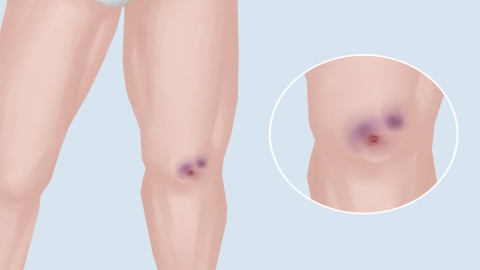What does it mean when there are bruises on the body?
Generally, bruising on the body may result from accidental bumps or compression, aging-related increased vessel fragility, vitamin C deficiency, idiopathic thrombocytopenic purpura, or coagulation disorders. It is recommended to seek medical attention promptly, identify the underlying cause, and then improve the condition under a doctor's guidance through general management, medication, and other treatments. Specific causes are analyzed as follows:

1. Accidental bumps or compression: During daily activities, accidentally bumping into furniture, falling, or experiencing physical pressure can cause rupture of subcutaneous capillaries and lead to bruising, often accompanied by localized tenderness. Within the first 48 hours after injury, apply ice packs for cold compression to reduce bleeding; after 48 hours, switch to warm compresses with a heated towel to promote absorption of the hematoma. Avoid re-injuring the affected area.
2. Aging-related vessel fragility: With age, subcutaneous blood vessels lose elasticity and their walls become thinner, making them prone to rupture even under minor force, leading to bruising—commonly seen in middle-aged and elderly individuals. In daily life, consume more foods rich in vitamin E, such as nuts and spinach, and maintain moderate exercise like walking or tai chi to enhance vascular elasticity. Avoid intense physical activity and excessive straining.
3. Vitamin C deficiency: Long-term dietary imbalance resulting in insufficient vitamin C intake impairs collagen synthesis, reducing vascular wall resilience and increasing bruising risk, possibly accompanied by gum bleeding. Patients may take vitamin C tablets, multivitamin tablets, or compound vitamin B tablets as directed by a physician to replenish nutrients.
4. Idiopathic thrombocytopenic purpura (ITP): Immune system abnormalities or bone marrow hematopoietic issues cause reduced platelet counts and impaired clotting function, leading to easy bruising, possibly accompanied by nosebleeds and gum bleeding. Patients should follow medical advice to use medications such as prednisone acetate tablets, methylprednisolone tablets, or intravenous immunoglobulin for treatment.
5. Coagulation disorders: Congenital deficiencies in clotting factors or conditions such as liver or kidney disease that reduce clotting factor production can lead to spontaneous bruising and prolonged bleeding after injury. Patients should take medications such as prothrombin complex concentrate, vitamin K1 injection, or tranexamic acid tablets under medical supervision to improve coagulation function.
In daily life, pay attention to safety to avoid bumps and injuries, wear soft and comfortable clothing to minimize skin friction. Maintain a balanced diet and avoid picky eating habits. Regular health check-ups can help detect and address potential health issues early, thereby reducing the occurrence of bruising.




